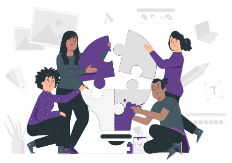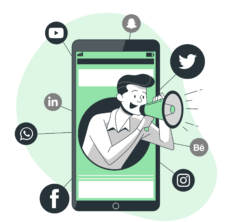Training
3.2 Digitally enhanced collaborative learning
3.2.1 Definitional characteristics
Through digitally enhanced collaborative learning the students are actively engaged with the information and new input in synchronous and asynchronous activities to develop collaborative, communicational skills, as well as critical thinking and creativity. The holistic approach [1] attempts to shape a collaborative learning context, where all aspects and elements of this context work together to enable a successful learning experience. It starts with defining the goals that are to be achieved and goes on with thoroughly selecting topics that are to be included, describing the milestones of the learning process, and putting in the spotlight the collaboration, reflection, and feedback. This approach involves the perspective of students and highlights the importance of preparing the students for the collaborative work by explaining the reasons and benefits of their active participation.
However, collaborative learning is a broad term that encompasses various methods, environments, and activities that encourage students to engage actively and use their intellectual abilities. It involves students working together in small groups of two or more to seek knowledge, solutions, or create a final product. Collaborative learning activities come in different forms but mainly focus on students exploring or applying the course material rather than relying solely on the teacher’s presentation or explanation [2].
3.2.2 Benefits and challenges
Benefits
The benefits of implementing digitally enhanced collaborative learning settings can be summarized as follows:
- In collaborative online learning settings students can actively participate in the learning and experiment with various online tools that support knowledge transfer.
- Working with cooperative discussion formats such as podcasts helps to train transversal skills like attentive communication.
- In well-designed collaborative learning environments gathering knowledge is a process, that happens incidentally. The inclusion of playful elements gives learning a competitive and fun factor which has a motivating effect.
- Digitally enhanced collaborative learning settings need a clear framework which supports group work performance and the development of teamwork skills such as cooperative behaviour.
- In collaborative learning settings, the focus is neither on the learning material nor the teacher, but on the students. This student-centred learning helps students build a sense of responsibility for knowledge acquisition and development.
Challenges
On the one hand using collaborative learning can lead to improve communication, motivation, and engagement as well as interaction and cooperation among a group of students and thus help to achieve the learning goals effectively. On the other hand, there still can occur a range of challenges for the students themselves as well as for teachers.
In general, challenges associated with collaborative learning in an online environment can be in the student, the teacher, the task itself or in technical factors:
- Challenge COMMUNICATION: difficulties in communication with peers
- Challenge COOPERATION & COLLABORATION: problems within the group of students, no ability to compromise, lack of sense of community, cultural and social differences
- Challenge LEADERSHIP: poor leadership skills of the lecturer
- Challenge FEEDBACK: missing feedback from lecturer and colleagues
- Challenge MOTIVATION: because of insufficient cooperation and communication, feedback, personal attitudes, disagreement among student`s group, withdrawal of members, lack of common learning goals etc.
- Challenge TECHNOLOGY & ADMINISTRATION: technical or organisational problems (internet, tools, conflict in schedules etc.)
3.2.3 Role of educator
Besides focusing on the content, the role of the educator in a collaborative setting reflects the need of support and constant guidance, monitoring, and coaching. The students’ readiness to learn in a collaborative setting, where they undertake an active role, has an important influence on the development of the learning context and its acceptance [1]. The supporting role of the educator is crucial and therefore the guidance with supporting strategy must be planned carefully.

Figure 1: The 12 roles of the teacher, adopted from [3, p. e4].
To improve teaching with educational technology, educators must possess comprehensive knowledge of the available tools. The range of technological options is very vast.
In the preparation phase, the educator must carefully select appropriate tools for her/his idea of collaborative activity in the course or a unit. At the beginning s/he needs to have a deep understanding of possible tools, its features, and availability to apply the desired scenario effectively. The ideation of the setting must occur in parallel with the choice of technology.
In the implementation or ‘playing’ phase, the educator has to offer support and guidance whenever needed. Some settings may be self-explanatory, and the learners advance autonomously. Nevertheless, some situations need to be additionally explained.
In the programme evaluation phase, the educator analyses the whole process and improves the content or creates own templates for other courses applying similar mechanisms.



